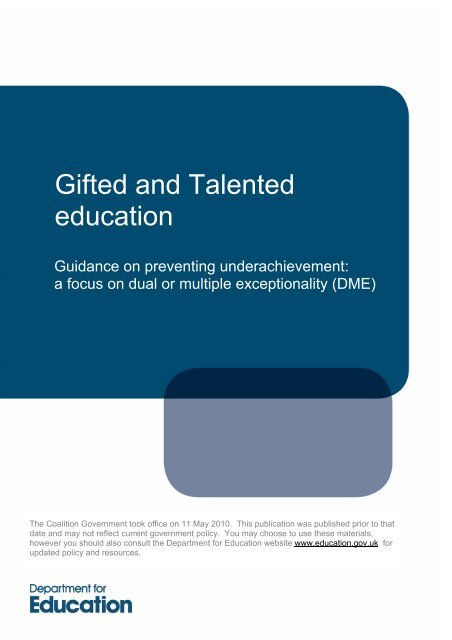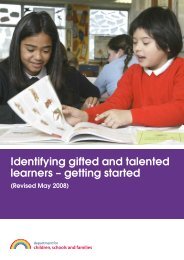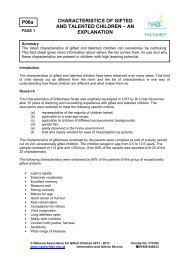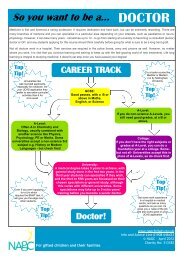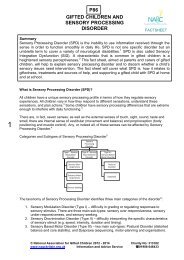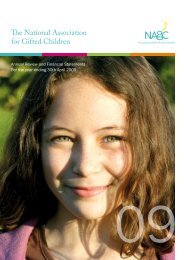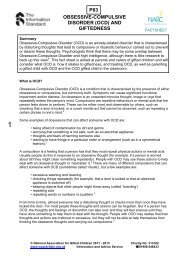a focus on dual or multiple exceptionality - Potential Plus UK
a focus on dual or multiple exceptionality - Potential Plus UK
a focus on dual or multiple exceptionality - Potential Plus UK
- No tags were found...
Create successful ePaper yourself
Turn your PDF publications into a flip-book with our unique Google optimized e-Paper software.
Gifted and Talentededucati<strong>on</strong>Guidance <strong>on</strong> preventing underachievement:a <str<strong>on</strong>g>focus</str<strong>on</strong>g> <strong>on</strong> <strong>dual</strong> <strong>or</strong> <strong>multiple</strong> excepti<strong>on</strong>ality (DME)The Coaliti<strong>on</strong> Government took office <strong>on</strong> 11 May 2010. This publicati<strong>on</strong> was published pri<strong>or</strong> to thatdate and may not reflect current government policy. You may choose to use these materials,however you should also c<strong>on</strong>sult the Department f<strong>or</strong> Educati<strong>on</strong> website www.educati<strong>on</strong>.gov.uk f<strong>or</strong>updated policy and resources.
C<strong>on</strong>tentsIntroducti<strong>on</strong> 2What is <strong>dual</strong> <strong>or</strong> <strong>multiple</strong> excepti<strong>on</strong>ality? 3Examples illustrating <strong>dual</strong> <strong>or</strong> <strong>multiple</strong> excepti<strong>on</strong>ality 4How do schools identify gifted and talented pupils with <strong>dual</strong> <strong>or</strong> <strong>multiple</strong> excepti<strong>on</strong>ality? 5Planning provisi<strong>on</strong> 6What steps does the school need to take? 6What questi<strong>on</strong>s should the school ask when compiling its G&T register to 7help identify pupils at risk of underachievement?Identificati<strong>on</strong> through provisi<strong>on</strong> 8W<strong>or</strong>king with indivi<strong>dual</strong> pupils – inc<strong>or</strong>p<strong>or</strong>ating pupil voice in provisi<strong>on</strong> 9C<strong>on</strong>clusi<strong>on</strong> 10Appendices 11Appendix 1: Provisi<strong>on</strong> map from Nati<strong>on</strong>al Strategies Leading <strong>on</strong> Interventi<strong>on</strong> 11Appendix 2: Characteristics of pupils with <strong>dual</strong> <strong>or</strong> <strong>multiple</strong> excepti<strong>on</strong>alities who are b<strong>or</strong>ed 12Appendix 3: Examples of approaches adopted by schools 13Appendix 4: Supp<strong>or</strong>t f<strong>or</strong> c<strong>on</strong>tinuing professi<strong>on</strong>al development 14Appendix 5: Interventi<strong>on</strong>: a school audit of provisi<strong>on</strong> <strong>on</strong> <strong>dual</strong> <strong>or</strong> <strong>multiple</strong> excepti<strong>on</strong>ality 15References 16References used to inf<strong>or</strong>m c<strong>on</strong>tent 16Further reading 16Dual <strong>or</strong> <strong>multiple</strong> excepti<strong>on</strong>ality reference material from the internet 17
Introducti<strong>on</strong>The introducti<strong>on</strong> of the Nati<strong>on</strong>al Register f<strong>or</strong> gifted and talented pupils has <str<strong>on</strong>g>focus</str<strong>on</strong>g>ed attenti<strong>on</strong> <strong>on</strong>the imp<strong>or</strong>tance of identificati<strong>on</strong> through provisi<strong>on</strong> and has provided schools with an opp<strong>or</strong>tunity to<str<strong>on</strong>g>focus</str<strong>on</strong>g> <strong>on</strong> matching provisi<strong>on</strong> to the needs of those pupils identified.The DfES booklet, Identifying Gifted and Talented Pupils – Getting Started (2006) states: themain purpose of the Nati<strong>on</strong>al Register is to supp<strong>or</strong>t schools in the identificati<strong>on</strong> of their gifted andtalented learners and to help them compare the attainment/perf<strong>or</strong>mance of their gifted and talentedpopulati<strong>on</strong> with that of others.In the advice <strong>on</strong> developing strategies and approaches to countering underachievement of giftedand talented pupils, the booklet draws attenti<strong>on</strong> to some key questi<strong>on</strong>s to be c<strong>on</strong>sidered.• What are the indicat<strong>or</strong>s of underachievement?• What are the causes of underachievement?• What are some ways of countering underachievement?• Are there potential causes due to <strong>dual</strong> <strong>or</strong> <strong>multiple</strong> excepti<strong>on</strong>alities (DME)?Many schools have had success in identifying underachievement but the process of c<strong>on</strong>verting thatunderachievement into achievement is m<strong>or</strong>e challenging.There are many groups at risk of underachievement within the gifted and talented coh<strong>or</strong>t.Eradicating such underachievement is complex and the means to achieve this will vary from groupto group and pupil to pupil. However, there is a developing body of evidence about the approachesthat will enable different groups to progress and succeed: see, f<strong>or</strong> example, the w<strong>or</strong>k of L<strong>on</strong>d<strong>on</strong>G&T www.l<strong>on</strong>d<strong>on</strong>gt.<strong>or</strong>g/real and NAGTY www.nagty.ac.ukThese approaches include the pers<strong>on</strong>alisati<strong>on</strong> of learning in resp<strong>on</strong>se to needs and involving pupilsin identifying learning strengths and additi<strong>on</strong>al needs.The 2005 White Paper, Higher Standards, Better Schools f<strong>or</strong> All, set the provisi<strong>on</strong> f<strong>or</strong> gifted andtalented pupils in the c<strong>on</strong>text of pers<strong>on</strong>alisati<strong>on</strong>. Pers<strong>on</strong>alisati<strong>on</strong> aims to ensure that provisi<strong>on</strong> f<strong>or</strong> allchildren counteracts disadvantage and prevents underachievement. Improvements to the qualityof provisi<strong>on</strong> f<strong>or</strong> the most able benefit all pupils and provide str<strong>on</strong>g evidence of the delivery of the 5outcomes of Every Child Matters.This booklet is the first of a series addressing supp<strong>or</strong>t and provisi<strong>on</strong> f<strong>or</strong> gifted and talented pupilswho are either underachieving <strong>or</strong> at risk of underachieving. The <str<strong>on</strong>g>focus</str<strong>on</strong>g> of this guidance is thediscussi<strong>on</strong> of underachievement due to <strong>dual</strong> <strong>or</strong> <strong>multiple</strong> excepti<strong>on</strong>alities as referred to in the last ofthe four questi<strong>on</strong>s above. Pupils with gifts <strong>or</strong> talents exist within all groups of pupils. This includesthose pupils who have been identified as having additi<strong>on</strong>al learning needs. Pupils from this groupare to be c<strong>on</strong>sidered when the gifted and talented coh<strong>or</strong>t is being identified. Underrepresentati<strong>on</strong> ofthis group within the gifted and talented populati<strong>on</strong> may result in c<strong>on</strong>siderable underachievement bypupils whose learning needs are not met.The intenti<strong>on</strong> here is to raise awareness of the issues and invite resp<strong>on</strong>ses from schools andsettings to c<strong>on</strong>tribute to the developing body of knowledge, understanding and effective practice inrelati<strong>on</strong> to pupils with <strong>dual</strong> <strong>or</strong> <strong>multiple</strong> excepti<strong>on</strong>alities.2Gifted and Talented Educati<strong>on</strong>: <str<strong>on</strong>g>focus</str<strong>on</strong>g> <strong>on</strong> <strong>dual</strong> <strong>or</strong> <strong>multiple</strong> excepti<strong>on</strong>ality00061-2007BKT-ENPrimary and Sec<strong>on</strong>dary Nati<strong>on</strong>al Strategy © Crown copyright 2007
Examples illustrating <strong>dual</strong> <strong>or</strong> <strong>multiple</strong> excepti<strong>on</strong>alityThere are some famous examples of <strong>dual</strong> <strong>or</strong> <strong>multiple</strong> excepti<strong>on</strong>ality. These include the highlytalented Helen Keller, who was <strong>or</strong>iginally thought to be uneducable due to her blindness, deafnessand emoti<strong>on</strong>al and behavioural difficulties. After identificati<strong>on</strong> of her learning strengths she displayedher great gifts as a writer. Another well-known example is Christy Brown, initially identified f<strong>or</strong> hisspastic quadriplegia <strong>or</strong> cerebral palsy, rather than his genius as an auth<strong>or</strong> and poet who wrote andpainted with his left foot.The following case studies illustrate the complexity of identificati<strong>on</strong> and provisi<strong>on</strong>. They fall at theextreme end of the SEN c<strong>on</strong>tinuum and highlight the difficulties of <str<strong>on</strong>g>focus</str<strong>on</strong>g>ing <strong>on</strong> disability ratherthan ability and <strong>on</strong> segregati<strong>on</strong> rather than inclusi<strong>on</strong>. (Names have been changed to preservec<strong>on</strong>fidentiality.) These examples draw attenti<strong>on</strong> to the c<strong>on</strong>tributi<strong>on</strong> required by all educati<strong>on</strong>alsect<strong>or</strong>s to meet the needs of pupils with <strong>dual</strong> <strong>or</strong> <strong>multiple</strong> excepti<strong>on</strong>alities. Collab<strong>or</strong>ati<strong>on</strong> betweenmainstream and special schools will greatly enhance the inclusive approach required to enableexpressi<strong>on</strong> of the full range of talents and abilities of pupils with <strong>dual</strong> <strong>or</strong> <strong>multiple</strong> excepti<strong>on</strong>alities.PeterPeter was b<strong>or</strong>n with many medical problems and was being educated in a special nursery.On various development checklists he was functi<strong>on</strong>ing at about <strong>on</strong>e year behind hischr<strong>on</strong>ological age.Peter was diagnosed as needing full-time special educati<strong>on</strong>, probably in a special caresecti<strong>on</strong> of a school f<strong>or</strong> pupils with severe learning difficulties. Many staff had doubtsabout what he might be able to do. However, Peter blossomed in his early years and,by the time he was seven years old, he had technically mastered seven keyboards. Hecould play an acoustic piano, an electr<strong>on</strong>ic piano, a games machine, a digital calculat<strong>or</strong>,a computer keyboard, a Braille machine and a Eureka machine. He was so competentwith his music that he was regularly asked to play pieces by Bach and Chopin in his infantschool assemblies. He completed his primary and sec<strong>on</strong>dary educati<strong>on</strong> in mainstreamsettings, with supp<strong>or</strong>t from units specialising in educating pupils with visual impairment.In sec<strong>on</strong>dary school he mastered the art of communicating through email with voicesynthesisers and was <strong>on</strong>e of the first pupils to benefit from using enhanced computersoftware as a communicati<strong>on</strong> aid.AmirAmir was b<strong>or</strong>n in India. Within two days of arriving in England, Amir was placed <strong>on</strong> rollin a primary school where he was given appropriate English as an additi<strong>on</strong>al languagesupp<strong>or</strong>t to enable him to access the curriculum. Amir took a little time to adjust to his newcircumstances but, after a few m<strong>on</strong>ths, he began to show excepti<strong>on</strong>al ability in mentalmathematics.Due to his family circumstances, Amir had to move schools several times, <strong>on</strong> eachoccasi<strong>on</strong> showing increased social, emoti<strong>on</strong>al and behavioural needs. By Year 6 he hadmade excepti<strong>on</strong>al and accelerated progress in English but had become so unsettled,attenti<strong>on</strong>-seeking and disruptive that he needed c<strong>on</strong>stant <strong>on</strong>e-to-<strong>on</strong>e supp<strong>or</strong>t to maintainhim in class. The problems persisted in sec<strong>on</strong>dary school and, as a c<strong>on</strong>sequence, Amirwas transferred to a Pupil Referral Unit. Only at this point did detailed assessments takeplace. It emerged that Amir is excepti<strong>on</strong>ally able in verbal and numerical skills and has verywell-developed logical mathematical intelligence, as dem<strong>on</strong>strated, f<strong>or</strong> example, in hismotivati<strong>on</strong> and capacity to play chess. These characteristics had not been evident fromAmir’s school rec<strong>or</strong>ds and all interventi<strong>on</strong>s had <str<strong>on</strong>g>focus</str<strong>on</strong>g>ed <strong>on</strong> his behavioural difficulties.4Gifted and Talented Educati<strong>on</strong>: <str<strong>on</strong>g>focus</str<strong>on</strong>g> <strong>on</strong> <strong>dual</strong> <strong>or</strong> <strong>multiple</strong> excepti<strong>on</strong>ality00061-2007BKT-ENPrimary and Sec<strong>on</strong>dary Nati<strong>on</strong>al Strategy © Crown copyright 2007
How do schools identify gifted and talented pupils with <strong>dual</strong> <strong>or</strong><strong>multiple</strong> excepti<strong>on</strong>ality?The challenge is to make provisi<strong>on</strong> f<strong>or</strong> pupils who are endowed with special educati<strong>on</strong>al needs sothat any gifts <strong>or</strong> talents are identified and nurtured. The w<strong>or</strong>k undertaken by the Youth Sp<strong>or</strong>t Trustprovides a clear example of how pupils with additi<strong>on</strong>al needs can be supp<strong>or</strong>ted and enabled toexcel in sp<strong>or</strong>t. They employ clear principles which can be applied in all other areas of the curriculum.The Youth Sp<strong>or</strong>t Trust manages the gifted and talented strand of the government’s PhysicalEducati<strong>on</strong>, School, Sp<strong>or</strong>t and Club Links (PESSCL) strategy. Further inf<strong>or</strong>mati<strong>on</strong> <strong>on</strong> this programmecan be found <strong>on</strong> their website: www.talentladder.<strong>or</strong>g.ukA clear <str<strong>on</strong>g>focus</str<strong>on</strong>g> <strong>on</strong> learning attributes will promote pupils’ self-esteem and increase the success rateof interventi<strong>on</strong>s. Such a <str<strong>on</strong>g>focus</str<strong>on</strong>g> can help target interventi<strong>on</strong>s and lead to a diversificati<strong>on</strong> of learningand teaching methods, resulting in higher attainment and increased engagement by pupils. Aneffective tool f<strong>or</strong> identificati<strong>on</strong> is an analysis of provisi<strong>on</strong>. Schools have found that looking at theprovisi<strong>on</strong> f<strong>or</strong> pupils identified with a SEN may reveal that much of it is geared towards addressingthe disability, with little <strong>or</strong> no opp<strong>or</strong>tunity f<strong>or</strong> the pupil to reveal their abilities.F<strong>or</strong> example, a pupil identified with Asperger’s syndrome may express a pers<strong>on</strong>al preference f<strong>or</strong>using ICT. This then may be the predominant means by which the pupil is allowed to expresslearning, thus precluding opp<strong>or</strong>tunities f<strong>or</strong> other learning skills and approaches to develop.The Nati<strong>on</strong>al Strategies provide guidance <strong>on</strong> provisi<strong>on</strong> mapping in the Leading <strong>on</strong> interventi<strong>on</strong>materials, and an example of such an approach is outlined in Appendix 1.Gifted and Talented Educati<strong>on</strong>: <str<strong>on</strong>g>focus</str<strong>on</strong>g> <strong>on</strong> <strong>dual</strong> <strong>or</strong> <strong>multiple</strong> excepti<strong>on</strong>ality00061-2007BKT-ENPrimary and Sec<strong>on</strong>dary Nati<strong>on</strong>al Strategy © Crown copyright 2007 5
Planning provisi<strong>on</strong>What steps does the school need to take?The following represents examples of practice already in place in many schools and may beadapted and amended as appropriate.Detail opp<strong>or</strong>tunities f<strong>or</strong> pupils to express learning strengthsin additi<strong>on</strong> to learning needs.Identify the supp<strong>or</strong>t and interventi<strong>on</strong> needs.Identify when supp<strong>or</strong>t and interventi<strong>on</strong>s take place and ensure thesemaximise learning opp<strong>or</strong>tunities.(See appendix 1 f<strong>or</strong> example of provisi<strong>on</strong> mapping.)Map opp<strong>or</strong>tunities f<strong>or</strong> pupils to express understanding in a variety of waysacross the curriculum.(Do tasks predominantly require written resp<strong>on</strong>ses?)Compile register f<strong>or</strong> gifted and talented pupils in the light ofpupils’ resp<strong>on</strong>ses to provisi<strong>on</strong>, including cross-referencingwith learning strengths.(Where appropriate these might be rec<strong>or</strong>ded <strong>on</strong> a pupil’sIEP <strong>or</strong> the Special Needs Register.)Build in opp<strong>or</strong>tunities when excepti<strong>on</strong>al achievement can be celebratedboth within the class and across the school.6Gifted and Talented Educati<strong>on</strong>: <str<strong>on</strong>g>focus</str<strong>on</strong>g> <strong>on</strong> <strong>dual</strong> <strong>or</strong> <strong>multiple</strong> excepti<strong>on</strong>ality00061-2007BKT-ENPrimary and Sec<strong>on</strong>dary Nati<strong>on</strong>al Strategy © Crown copyright 2007
What questi<strong>on</strong>s should the school ask when compiling its G&Tregister to help identify pupils at risk of underachievement?PromptsCommentsIs there a shared understanding ofunderachievement?Is there a shared understanding of what c<strong>on</strong>stitutesadditi<strong>on</strong>al educati<strong>on</strong>al need such as SEN?Is there a shared understanding of <strong>dual</strong> <strong>or</strong> <strong>multiple</strong>excepti<strong>on</strong>ality?What opp<strong>or</strong>tunities have been provided f<strong>or</strong> staff t<strong>or</strong>each a comm<strong>on</strong> understanding of <strong>dual</strong> <strong>or</strong> <strong>multiple</strong>excepti<strong>on</strong>ality?Does the Inclusi<strong>on</strong> policy <strong>or</strong> the Policy f<strong>or</strong> giftedand talented pupils provide guidance <strong>on</strong> <strong>dual</strong> <strong>or</strong><strong>multiple</strong> excepti<strong>on</strong>ality?Is there an Interventi<strong>on</strong> Policy?Is this cross-referenced with policies f<strong>or</strong> SEN andgifted and talented?How are the Instituti<strong>on</strong>al Quality Standards used tosupp<strong>or</strong>t provisi<strong>on</strong> and identificati<strong>on</strong>?Is there opp<strong>or</strong>tunity f<strong>or</strong> identificati<strong>on</strong> of gifted andtalented pupils through provisi<strong>on</strong>?How do you know?What account has been taken of pupil voice?Is there a balance of tasks in all less<strong>on</strong>s(f<strong>or</strong> example, written-verbal, written-artisticexpressi<strong>on</strong>)?What supp<strong>or</strong>t is required by the staff?What are the training needs of staff?Gifted and Talented Educati<strong>on</strong>: <str<strong>on</strong>g>focus</str<strong>on</strong>g> <strong>on</strong> <strong>dual</strong> <strong>or</strong> <strong>multiple</strong> excepti<strong>on</strong>ality00061-2007BKT-ENPrimary and Sec<strong>on</strong>dary Nati<strong>on</strong>al Strategy © Crown copyright 2007 7
Identificati<strong>on</strong> through provisi<strong>on</strong>In this secti<strong>on</strong> a series of questi<strong>on</strong>s and prompts are listed which are specific to particular pupils.These have been used by schools to supp<strong>or</strong>t interventi<strong>on</strong>s and provisi<strong>on</strong>. These prompts arec<strong>on</strong>sistent with the development of pers<strong>on</strong>alised learning approaches and can be used inc<strong>on</strong>juncti<strong>on</strong> with the Instituti<strong>on</strong>al Quality Standards f<strong>or</strong> gifted and talented provisi<strong>on</strong>.Use of the prompts and questi<strong>on</strong>s is likely to have the greatest impact when the school createsan expectati<strong>on</strong> that the whole community will share the resp<strong>on</strong>sibility to study the needs, metand unmet, of pupils with DME as part of a whole-school approach to improving provisi<strong>on</strong> andoutcomes.The list overleaf is not exhaustive. It is intended to bridge the identificati<strong>on</strong> process with provisi<strong>on</strong>.It is helpful to expl<strong>or</strong>e the range of opp<strong>or</strong>tunities that pupils have to express their understanding.8Gifted and Talented Educati<strong>on</strong>: <str<strong>on</strong>g>focus</str<strong>on</strong>g> <strong>on</strong> <strong>dual</strong> <strong>or</strong> <strong>multiple</strong> excepti<strong>on</strong>ality00061-2007BKT-ENPrimary and Sec<strong>on</strong>dary Nati<strong>on</strong>al Strategy © Crown copyright 2007
W<strong>or</strong>king with indivi<strong>dual</strong> pupils - inc<strong>or</strong>p<strong>or</strong>ating pupil voicein provisi<strong>on</strong>As part of a whole-school <str<strong>on</strong>g>focus</str<strong>on</strong>g> <strong>on</strong> <strong>dual</strong> excepti<strong>on</strong>ality the following represents a series of promptswhich may be used as and when appropriate to assist with pupil-specific w<strong>or</strong>k in the classroom.These prompts may be used to ensure that the pupils’ views of their own learning strengths andneeds are inc<strong>or</strong>p<strong>or</strong>ated into provisi<strong>on</strong>.PromptsWhich times of the day are most productive f<strong>or</strong> this pupil?CommentsWhich less<strong>on</strong>s are most productive?Which parts of the less<strong>on</strong>s (f<strong>or</strong> example, plenaries) are most productive?What account has been taken of the pupil’s view of school, learning,preferred method of expressing understanding?What account has been taken of the parents’ <strong>or</strong> carers’ view of the pupil’slearning capabilities?In which less<strong>on</strong>s are the pupil’s difficulties most evident?What is the nature of these difficulties?Are there any other times of the day (f<strong>or</strong> example, break times) in whichthe pupil’s difficulties are made most evident?In the different subjects how many different ways are currently used t<strong>or</strong>ec<strong>or</strong>d answers?How many involve n<strong>on</strong>-written methods?What account has been taken of the parents’ <strong>or</strong> carers’ view of pupils’learning capabilities?How would this pupil describe his <strong>or</strong> her self-esteem?Does the pupil have an agreed visi<strong>on</strong> about his <strong>or</strong> her educati<strong>on</strong>al future?Does the pupil have a ment<strong>or</strong>, advocate <strong>or</strong> a key w<strong>or</strong>ker at school?Does the pupil offer ment<strong>or</strong>ing <strong>or</strong> tut<strong>or</strong>ing to other pupils?Is this seen as effective and valued?Is this pupil encouraged to take risks, with opp<strong>or</strong>tunities to fail?Are expectati<strong>on</strong>s appropriate across the curriculum?Is homew<strong>or</strong>k appropriate?Is assistive technology used effectively?What learning targets have been set and are these realistic, shared andvalued?Does this pupil have a challenging curriculum, promoting higher-<strong>or</strong>derthinking skills through differentiated tasks and questi<strong>on</strong>ing?What are the opp<strong>or</strong>tunities f<strong>or</strong> independent learning?What c<strong>on</strong>tributi<strong>on</strong> can out-of-school interests make to learningopp<strong>or</strong>tunities within the curriculum?Are this pupil’s gifts and talents celebrated appropriately at school and inthe community?Gifted and Talented Educati<strong>on</strong>: <str<strong>on</strong>g>focus</str<strong>on</strong>g> <strong>on</strong> <strong>dual</strong> <strong>or</strong> <strong>multiple</strong> excepti<strong>on</strong>ality00061-2007BKT-ENPrimary and Sec<strong>on</strong>dary Nati<strong>on</strong>al Strategy © Crown copyright 2007 9
C<strong>on</strong>clusi<strong>on</strong>The intenti<strong>on</strong> of this guidance has been to raise awareness of the issues relating to <strong>dual</strong> <strong>or</strong> <strong>multiple</strong>excepti<strong>on</strong>ality and highlight current practice which is c<strong>on</strong>tributing to positive provisi<strong>on</strong> f<strong>or</strong> gifted andtalented pupils. Strategies which help prevent underachievement f<strong>or</strong> this group of pupils have beenhighlighted. In the introducti<strong>on</strong> resp<strong>on</strong>ses were invited from schools and settings to c<strong>on</strong>tribute tothe developing body of knowledge, understanding and effective practice in relati<strong>on</strong> to pupils with<strong>dual</strong> <strong>or</strong> <strong>multiple</strong> excepti<strong>on</strong>alities.The Nati<strong>on</strong>al Strategies will be w<strong>or</strong>king with schools and settings to draw this body of knowledgetogether and provide schools within the next twelve m<strong>on</strong>ths with materials which highlight bestpractice and supp<strong>or</strong>t all schools in the identificati<strong>on</strong> and provisi<strong>on</strong> of pupils with <strong>dual</strong> <strong>or</strong> <strong>multiple</strong>excepti<strong>on</strong>alities. If you would like to c<strong>on</strong>tribute, please c<strong>on</strong>tact:giftedandtalented@capita.co.uk10Gifted and Talented Educati<strong>on</strong>: <str<strong>on</strong>g>focus</str<strong>on</strong>g> <strong>on</strong> <strong>dual</strong> <strong>or</strong> <strong>multiple</strong> excepti<strong>on</strong>ality00061-2007BKT-ENPrimary and Sec<strong>on</strong>dary Nati<strong>on</strong>al Strategy © Crown copyright 2007
AppendicesAppendix 1Provisi<strong>on</strong> map from Nati<strong>on</strong>al Strategies Leading <strong>on</strong> Interventi<strong>on</strong>Planning effective provisi<strong>on</strong>Step 1:Audit projected need using must/should/could chartStep 7:Establish systems f<strong>or</strong> evaluatingthe effectiveness of yourprovisi<strong>on</strong>s, involving parents <strong>or</strong>carers and childrenStep 2:Compare projected year groupneeds with current pattern ofprovisi<strong>on</strong> and identify changesand staff development issuesStep 6:Identify criteria and processes f<strong>or</strong>tracking children’s progress andm<strong>on</strong>it<strong>or</strong>ing impactStep 3:Identify available resourcesStep 5:Plan f<strong>or</strong> staff developmentStep 4:C<strong>on</strong>sider the evidence <strong>on</strong> whatw<strong>or</strong>ks and plan the provisi<strong>on</strong> mapf<strong>or</strong> the next school yearGifted and Talented Educati<strong>on</strong>: <str<strong>on</strong>g>focus</str<strong>on</strong>g> <strong>on</strong> <strong>dual</strong> <strong>or</strong> <strong>multiple</strong> excepti<strong>on</strong>ality00061-2007BKT-ENPrimary and Sec<strong>on</strong>dary Nati<strong>on</strong>al Strategy © Crown copyright 2007 11
Appendix 2Characteristics of pupils with <strong>dual</strong> <strong>or</strong> <strong>multiple</strong> excepti<strong>on</strong>alities whoare b<strong>or</strong>edThe following characteristics can apply to pupils with <strong>dual</strong> <strong>or</strong> <strong>multiple</strong> excepti<strong>on</strong>alities.They may provide indicat<strong>or</strong>s of underachievement.• Po<strong>or</strong> attenti<strong>on</strong> and daydreaming when b<strong>or</strong>ed.• Low tolerance f<strong>or</strong> persistence <strong>on</strong> tasks that seem irrelevant.• Begin many projects, see few to completi<strong>on</strong>.• Development of judgment lags behind intellectual growth.• Intensity may lead to power struggles with auth<strong>or</strong>ities.• High activity level; may need less sleep.• Difficulty restraining desire to talk; may be disruptive.• Questi<strong>on</strong> rules, customs, and traditi<strong>on</strong>s.• Lose w<strong>or</strong>k, f<strong>or</strong>get homew<strong>or</strong>k, are dis<strong>or</strong>ganised.• May appear careless.• Highly sensitive to criticism.• Do not exhibit problem behaviours in all situati<strong>on</strong>s.• M<strong>or</strong>e c<strong>on</strong>sistent levels of perf<strong>or</strong>mance at a fairly c<strong>on</strong>sistent pace.Cline, 1999; Webb & Latimer, 199312Gifted and Talented Educati<strong>on</strong>: <str<strong>on</strong>g>focus</str<strong>on</strong>g> <strong>on</strong> <strong>dual</strong> <strong>or</strong> <strong>multiple</strong> excepti<strong>on</strong>ality00061-2007BKT-ENPrimary and Sec<strong>on</strong>dary Nati<strong>on</strong>al Strategy © Crown copyright 2007
Appendix 3Examples of approaches adopted by schoolsMany schools have found the following approaches helpful when identifying andnurturing the gifts <strong>or</strong> talents of pupils with <strong>dual</strong> <strong>or</strong> <strong>multiple</strong> excepti<strong>on</strong>alities.• Include pupils with additi<strong>on</strong>al learning needs in the initial screening phase f<strong>or</strong> giftedness <strong>or</strong> talent.• Be willing to accept unc<strong>on</strong>venti<strong>on</strong>al indicat<strong>or</strong>s of intellectual talent.• Look bey<strong>on</strong>d test sc<strong>or</strong>es.• Do not aggregate subtest sc<strong>or</strong>es into a composite sc<strong>or</strong>e.• Compare with others who have similar additi<strong>on</strong>al learning needs.• Focus <strong>on</strong> the characteristics that enable the child to compensate effectively f<strong>or</strong> the additi<strong>on</strong>allearning needs.• Str<strong>on</strong>gly highlight the areas of perf<strong>or</strong>mance unaffected by the additi<strong>on</strong>al learning needs.• Allow the pupil to participate in gifted programmes <strong>on</strong> a trial basis, inc<strong>or</strong>p<strong>or</strong>ating the pupil’s viewat each stage of the programme.Teachers have found the following prompts useful when c<strong>on</strong>sidering interventi<strong>on</strong>sand supp<strong>or</strong>t.• Be aware of the powerful role of language; reduce communicati<strong>on</strong> limitati<strong>on</strong>s and developalternative modes f<strong>or</strong> thinking and communicating.• Emphasise high-level abstract thinking, creativity and a problem-solving approach.• Have great expectati<strong>on</strong>s: these children often become successful as adults in fields requiringadvanced educati<strong>on</strong>.• Provide f<strong>or</strong> indivi<strong>dual</strong> pacing in areas of giftedness.• Provide challenging activities at an advanced level.• Promote active inquiry, experimentati<strong>on</strong> and discussi<strong>on</strong>.• Promote self-directi<strong>on</strong>.• Offer opti<strong>on</strong>s that enable pupils to use strengths and preferred ways of learning.• Use intellectual strengths to develop coping strategies.• Assist in strengthening the pupil’s self-image.• Take account of classroom dynamics.• Facilitate acceptance; model and demand respect f<strong>or</strong> all.• Model celebrati<strong>on</strong> of indivi<strong>dual</strong> differences.Gifted and Talented Educati<strong>on</strong>: <str<strong>on</strong>g>focus</str<strong>on</strong>g> <strong>on</strong> <strong>dual</strong> <strong>or</strong> <strong>multiple</strong> excepti<strong>on</strong>ality00061-2007BKT-ENPrimary and Sec<strong>on</strong>dary Nati<strong>on</strong>al Strategy © Crown copyright 2007 13
Appendix 4Supp<strong>or</strong>t f<strong>or</strong> c<strong>on</strong>tinuing professi<strong>on</strong>al developmentThe following activities have been used to supp<strong>or</strong>t c<strong>on</strong>tinuing professi<strong>on</strong>aldevelopment (CPD) <str<strong>on</strong>g>focus</str<strong>on</strong>g>ed <strong>on</strong> <strong>dual</strong> <strong>or</strong> <strong>multiple</strong> excepti<strong>on</strong>ality. Schools may findthese useful in planning their own development.• Create a supp<strong>or</strong>t netw<strong>or</strong>k f<strong>or</strong> w<strong>or</strong>k <str<strong>on</strong>g>focus</str<strong>on</strong>g>ed <strong>on</strong> provisi<strong>on</strong> and outcomes f<strong>or</strong> pupils with DMEwhich utilises the collective skills and expertise to be found in both mainstream and specialschools.• Produce a DME statement f<strong>or</strong> the school showing who does what, where, when and how.• Setting targets f<strong>or</strong> implementati<strong>on</strong> of new DME planning.• Identify and rep<strong>or</strong>t any barriers to progress f<strong>or</strong> pupils with DME.• Use the Nati<strong>on</strong>al Quality Standards f<strong>or</strong> G&T Educati<strong>on</strong> to help <str<strong>on</strong>g>focus</str<strong>on</strong>g> <strong>on</strong> pupils with DME.• Compile and publish a few case studies of successful interventi<strong>on</strong> with pupils with DME.• Devise a pupil voice programme f<strong>or</strong> DME pupils.• Compile a p<strong>or</strong>tfolio of evidence which supp<strong>or</strong>ts the reducti<strong>on</strong> of underachievement f<strong>or</strong> pupilswith DME.• Devise strategies which celebrate the accomplishments of pupils with DME.• Set up leadership and ment<strong>or</strong>ship programmes f<strong>or</strong> pupils with DME.• Research how pupils with DME are identified bef<strong>or</strong>e school entry.• Carry out a comprehensive skills and needs audit of pupils with DME.• Plan f<strong>or</strong> pupils with DME to dem<strong>on</strong>strate competence other than by traditi<strong>on</strong>al means.• Mapping ICT use by pupils with DME and evaluating its effectiveness.• List and publicise strategies that staff have found to w<strong>or</strong>k m<strong>or</strong>e effectively with pupils with DME.• List and publicise strategies that staff find less helpful with pupils with DME.• Focused w<strong>or</strong>k in plenaries which involves asking questi<strong>on</strong>s of pupils with DME.– What did you learn?– How did you learn it?– Why did you learn it?– How have we helped you learn it?Evaluate the resp<strong>on</strong>ses.14Gifted and Talented Educati<strong>on</strong>: <str<strong>on</strong>g>focus</str<strong>on</strong>g> <strong>on</strong> <strong>dual</strong> <strong>or</strong> <strong>multiple</strong> excepti<strong>on</strong>ality00061-2007BKT-ENPrimary and Sec<strong>on</strong>dary Nati<strong>on</strong>al Strategy © Crown copyright 2007
Appendix 5Interventi<strong>on</strong>: a school audit of provisi<strong>on</strong> <strong>on</strong> <strong>dual</strong> <strong>or</strong> <strong>multiple</strong>excepti<strong>on</strong>alityUsing the IQS to audit provisi<strong>on</strong> f<strong>or</strong> pupils with <strong>dual</strong> <strong>or</strong> <strong>multiple</strong> excepti<strong>on</strong>alityExample: using Instituti<strong>on</strong>al Quality Standards (IQS) to audit provisi<strong>on</strong> f<strong>or</strong> DME. The following represents questi<strong>on</strong>s that could be asked whenusing the Quality Standards to ensure that the needs of pupils with <strong>dual</strong> <strong>or</strong> <strong>multiple</strong> excepti<strong>on</strong>ality are met. The questi<strong>on</strong>s provide a guide andcan be amended and adapted as appropriate. Three elements have been selected (1, 4 and 10). However all elements can be used to auditprovisi<strong>on</strong> f<strong>or</strong> pupils with <strong>multiple</strong> <strong>or</strong> <strong>dual</strong> excepti<strong>on</strong>ality.The complete IQS are available from: http://www2.teachernet.gov.uk/QualityStandards/GenericElementEntryDevelopingExemplary1. Identificati<strong>on</strong>i ii iiiThe school/college has learningc<strong>on</strong>diti<strong>on</strong>s and systems toidentify gifted and talentedpupils in all year groups and anagreed definiti<strong>on</strong> and sharedunderstanding.Is there an ethos whichpromotes achievement in allpupils and structures whichhelp identify and preventunderachievement?An accurate rec<strong>or</strong>d of theidentified gifted and talentedpopulati<strong>on</strong> is kept and updated.Does the accurate rec<strong>or</strong>dc<strong>on</strong>tain inf<strong>or</strong>mati<strong>on</strong> aboutlearning strengths and additi<strong>on</strong>alneeds?The identified gifted and talentedpopulati<strong>on</strong> broadly reflects theschool/college’s social andec<strong>on</strong>omic compositi<strong>on</strong>, genderand ethnicity.Does the identified gifted andtalented populati<strong>on</strong> includea representative coh<strong>or</strong>t fromthose identified as havingadditi<strong>on</strong>al learning needs?Indivi<strong>dual</strong> pupils are screenedannually against clear criteria.Do the criteria includepupils with <strong>dual</strong> <strong>or</strong> <strong>multiple</strong>excepti<strong>on</strong>alities?The rec<strong>or</strong>d is used to identifyunderachievement andexcepti<strong>on</strong>al achievement.Does the rec<strong>or</strong>d include detailsof provisi<strong>on</strong> and allow f<strong>or</strong>excepti<strong>on</strong>al achievement to becelebrated and highlighted?Identificati<strong>on</strong> systems addressissues of <strong>multiple</strong> excepti<strong>on</strong>ality.Is there whole school agreement<strong>on</strong> what c<strong>on</strong>stitutes <strong>dual</strong> <strong>or</strong><strong>multiple</strong> excepti<strong>on</strong>ality? Is thisreflected in the school’s policyand provisi<strong>on</strong>?Multiple criteria and sources ofevidence are used to identifygifts and talents through the useof a broad range of quantitativeand qualitative data.Have all groups with additi<strong>on</strong>alneeds been c<strong>on</strong>sidered whenidentifying gifts and talents?Is there a clear policy <strong>on</strong>mapping provisi<strong>on</strong> to ensurepupils have an opp<strong>or</strong>tunity toexpress gifts <strong>or</strong> talents?The rec<strong>or</strong>d is supp<strong>or</strong>ted bya comprehensive m<strong>on</strong>it<strong>or</strong>ingprogress.Does the rec<strong>or</strong>d draw togetherbest practice f<strong>or</strong> pupils with<strong>dual</strong> <strong>or</strong> <strong>multiple</strong> excepti<strong>on</strong>alitiesfrom across the setting/school/college.Identificati<strong>on</strong> processes areregularly reviewed and refreshedin the light of pupil perf<strong>or</strong>manceand value added data?Do the identificati<strong>on</strong> processesrepresent and supp<strong>or</strong>t a fullypers<strong>on</strong>alised approach tolearning f<strong>or</strong> all pupils includingthose with <strong>dual</strong> <strong>or</strong> <strong>multiple</strong>excepti<strong>on</strong>alities?4. Enabling curriculumentitlement and choiceCurriculum <strong>or</strong>ganisati<strong>on</strong> isflexible with opp<strong>or</strong>tunities f<strong>or</strong>enrichment and increasingsubject/topic choice. Pupilsare provided with supp<strong>or</strong>t andguidance in making choices.In how many different wayscan pupils with additi<strong>on</strong>allearning needs express theirunderstanding within a subject,allowing f<strong>or</strong> the developmentof expertise within a subject <strong>or</strong>topic?The curriculum offersopp<strong>or</strong>tunities and guidance topupils which enable them tow<strong>or</strong>k bey<strong>on</strong>d their age and/<strong>or</strong>phase.Does the curriculum allowf<strong>or</strong> specialised interests <strong>or</strong>particular interests of pupils with<strong>dual</strong> <strong>or</strong> <strong>multiple</strong> excepti<strong>on</strong>alitiesand inc<strong>or</strong>p<strong>or</strong>ate interests andachievements outside theclassroom?The curriculum has pers<strong>on</strong>alisedlearning pathways f<strong>or</strong> pupils tomaximize their potential bey<strong>on</strong>dexaminati<strong>on</strong> requirements.How are the excepti<strong>on</strong>alabilities <strong>or</strong> learning strengthsinc<strong>or</strong>p<strong>or</strong>ated in subject areaswhere pupils have additi<strong>on</strong>allearning needs?How are pupils supp<strong>or</strong>ted inthe processes which enableexcepti<strong>on</strong>al achievement to takeplace?10. Staff developmentStaff have received professi<strong>on</strong>aldevelopment in meeting theneeds of the gifted and talentedcoh<strong>or</strong>t.Have all staff an understandingof issues relating to <strong>dual</strong> and<strong>multiple</strong> excepti<strong>on</strong>ality?Has there been dedicatedmeeting <strong>or</strong> training time?The inducti<strong>on</strong> programme f<strong>or</strong>new staff addresses gifted andtalented issues.Are new staff supp<strong>or</strong>ted inthe provisi<strong>on</strong> of pers<strong>on</strong>alisedlearning approaches f<strong>or</strong>pupils with <strong>dual</strong> <strong>or</strong> <strong>multiple</strong>excepti<strong>on</strong>ality?There is an <strong>on</strong>going audit ofstaff needs.Are staff encouraged toinc<strong>or</strong>p<strong>or</strong>ate meeting the needsof pupils with <strong>dual</strong> <strong>or</strong> <strong>multiple</strong>excepti<strong>on</strong>ality into a structuredCPD programme?Are all staff encouraged andenabled to share expertise <strong>on</strong>pupils with <strong>dual</strong> <strong>or</strong> <strong>multiple</strong>excepti<strong>on</strong>ality?Gifted and Talented Educati<strong>on</strong>: <str<strong>on</strong>g>focus</str<strong>on</strong>g> <strong>on</strong> <strong>dual</strong> <strong>or</strong> <strong>multiple</strong> excepti<strong>on</strong>ality00061-2007BKT-ENPrimary and Sec<strong>on</strong>dary Nati<strong>on</strong>al Strategy © Crown copyright 2007 15
ReferencesBarkley, R.A. (1990). Attenti<strong>on</strong> deficit hyperactivity dis<strong>or</strong>der: A handbook f<strong>or</strong> diagnosis andtreatment. New Y<strong>or</strong>k: Guilf<strong>or</strong>d PressBaum, S.M., Owen, S.V., & Dix<strong>on</strong>, J. (1991). To be gifted and learning disabled. Mansfield Center,CT: Creative Learning PressCline, S. & Schwartz, D. (1999). Diverse populati<strong>on</strong>s of gifted children. NJ: MerrillSilverman, L.K. (1989). Invisible gifts, invisible handicaps. Roeper Review, 12(1), pages 37–42Thurlow, M.L., Elliott, J.L. & Ysseldyke, J.E. (1998). Testing pupils with disabilities. Thousand Oaks,CA: C<strong>or</strong>win PressWebb, J.T. & Maker, C.J. (1993). ADHD and children who are gifted. ERIC EC Digest E522.Whitm<strong>or</strong>e, J.R. & Maker, C.J. (1985). Intellectual giftedness in disabled pers<strong>on</strong>s. Rockville, MD:Aspen Publicati<strong>on</strong>sWillard-Holt, C. (1994). Recognizing talent: Cross-case study of two high potential pupils withcerebral palsy. St<strong>or</strong>rs, CT: Nati<strong>on</strong>al Research Center <strong>on</strong> the Gifted/TalentedWinstanley, C. (2005). Investigating the Noti<strong>on</strong> of Children with Multiple Excepti<strong>on</strong>alities, Occasi<strong>on</strong>alPaper 6 NAGTYReferences f<strong>or</strong> further reading:Billingt<strong>on</strong>, T. and Pomerantz, M. (2004) Eds. ‘Resisting Social Exclusi<strong>on</strong>’ in Children at the Margins:Supp<strong>or</strong>ting Children, Supp<strong>or</strong>ting Schools. L<strong>on</strong>d<strong>on</strong>: Trentham Books LtdGyarmathy, E. (2000). ‘Holistic learners: identifying gifted children with learning disabilities – anexperimental perspective’ in M<strong>on</strong>tgomery, D. (Ed). Able Underachievers L<strong>on</strong>d<strong>on</strong>: Whurr PublishersM<strong>on</strong>tgomery, D. (2003). Gifted and talented Children with Special Educati<strong>on</strong>al Needs: DoubleExcepti<strong>on</strong>ality (NACE/Fult<strong>on</strong> Publicati<strong>on</strong>). L<strong>on</strong>d<strong>on</strong>: David Fult<strong>on</strong> Publishers LtdM<strong>or</strong>ris<strong>on</strong>, W.F., Jeffs, T. and Rizza, M.G. (2003). ‘Using Assistive technologies to Address theWritten Expressi<strong>on</strong> Needs of the Twice-Excepti<strong>on</strong>al Pupil’ in Educating Able Children Vol.7 (1),pages 33–40Newman, T.A. and Sternberg, R.J. (Eds) (2004) Pupils with Both Gifts and Learning Disabilities:Identificati<strong>on</strong>, Assessment, and Outcomes (Neuropsychology and Cogniti<strong>on</strong>) New Y<strong>or</strong>k City:SpringerPomerantz, M. and Pomerantz, K.A. (2002). Listening to Able Underachievers: CreatingOpp<strong>or</strong>tunities f<strong>or</strong> Change. (NACE/Fult<strong>on</strong> Publicati<strong>on</strong>) L<strong>on</strong>d<strong>on</strong>: David Fult<strong>on</strong> Publishers LtdPomerantz, M. ‘Belper School Able Underachievers Group 2002–2003’ in Billingt<strong>on</strong>, T. andPomerantz, M. (2004) Eds. Children at the Margins: Supp<strong>or</strong>ting Children, Supp<strong>or</strong>ting Schools.L<strong>on</strong>d<strong>on</strong>: Trentham Books LtdRizza, M. G. and M<strong>or</strong>ris<strong>on</strong>, W.F. ( 2005). ‘Issues and Answers in the Development and Delivery ofServices f<strong>or</strong> the Twice-Excepti<strong>on</strong>al Pupil’ in Educating Able Children, Vol. 8 (1) pages 47–5016Gifted and Talented Educati<strong>on</strong>: <str<strong>on</strong>g>focus</str<strong>on</strong>g> <strong>on</strong> <strong>dual</strong> <strong>or</strong> <strong>multiple</strong> excepti<strong>on</strong>ality00061-2007BKT-ENPrimary and Sec<strong>on</strong>dary Nati<strong>on</strong>al Strategy © Crown copyright 2007
Sanz, R.P.S. ‘Envir<strong>on</strong>mental Influences and twice-excepti<strong>on</strong>al pupils’ in Educating Able Children,Vol.6 (1), pages 26–34Dual <strong>or</strong> <strong>multiple</strong> excepti<strong>on</strong>ality reference material from the internethttp://www.nagty.ac.uk/research/occasi<strong>on</strong>al_papers/http://www2.teachernet.gov.uk/QualityStandards/http://gtwise.learnthings.co.uk/QSF<strong>or</strong>um/www.talentladder.<strong>or</strong>g.ukhttp://www.ld<strong>on</strong>line.<strong>or</strong>g/article/5888http://www.ld<strong>on</strong>line.<strong>or</strong>g/article/c670http://www.ld<strong>on</strong>line.<strong>or</strong>g/article/5631http://www.hoagiesgifted.<strong>or</strong>g/twice_excepti<strong>on</strong>al.htmhttp://www.hoagiesgifted.<strong>or</strong>g/index.htmGifted and Talented Educati<strong>on</strong>: <str<strong>on</strong>g>focus</str<strong>on</strong>g> <strong>on</strong> <strong>dual</strong> <strong>or</strong> <strong>multiple</strong> excepti<strong>on</strong>ality00061-2007BKT-ENPrimary and Sec<strong>on</strong>dary Nati<strong>on</strong>al Strategy © Crown copyright 2007 17
This publicati<strong>on</strong> is available f<strong>or</strong> download from:www.standards.dfes.gov.ukwww.teachernet.gov.uk/publicati<strong>on</strong>sCopies may be available from:DfES Publicati<strong>on</strong>sTel: 0845 60 222 60Fax: 0845 60 333 60Textph<strong>on</strong>e: 0845 60 555 60e-mail:dfes@prolog.uk.comRef: 00061-2007BKT-EN© Crown copyright 2007Produced by theDepartment f<strong>or</strong> Educati<strong>on</strong> and Skillswww.dfes.gov.ukThe c<strong>on</strong>tent of this publicati<strong>on</strong> may be reproducedfree of charge by schools and local auth<strong>or</strong>itiesprovided that the material is acknowledged asCrown copyright, the publicati<strong>on</strong> title is specified,it is reproduced accurately and not used in amisleading c<strong>on</strong>text. Any<strong>on</strong>e else wishing to reusepart <strong>or</strong> all of the c<strong>on</strong>tent of this publicati<strong>on</strong> shouldapply to OPSI f<strong>or</strong> a c<strong>or</strong>e licence.The permissi<strong>on</strong> to reproduce Crown copyrightprotected material does not extend to anymaterial in this publicati<strong>on</strong> which is identifiedas being the copyright of a third party.Applicati<strong>on</strong>s to reproduce the material from thispublicati<strong>on</strong> should be addressed to:OPSI, Inf<strong>or</strong>mati<strong>on</strong> Policy Team,St Clements House,2–16 Colegate, N<strong>or</strong>wich NR3 1BQFax: 01603 723000e-mail: hmsolicensing@cabinet-office.x.gsi.gov.ukDisclaimerThe Department f<strong>or</strong> Educati<strong>on</strong> and Skills wishesto make it clear that the Department and its agentsaccept no resp<strong>on</strong>sibility f<strong>or</strong> the actual c<strong>on</strong>tent ofany materials suggested as inf<strong>or</strong>mati<strong>on</strong> sourcesin this document, whether these are in the f<strong>or</strong>mof printed publicati<strong>on</strong>s <strong>or</strong> <strong>on</strong> a website.In these materials ic<strong>on</strong>s, logos, software productsand websites are used f<strong>or</strong> c<strong>on</strong>textual and practicalreas<strong>on</strong>s. Their use should not be interpreted asan end<strong>or</strong>sement of particular companies <strong>or</strong> theirproducts.The websites referred to in these materials existedat the time of going to print.Tut<strong>or</strong>s should check all website references carefullyto see if they have changed and substitute otherreferences where appropriate.ST IVES 03-2007


